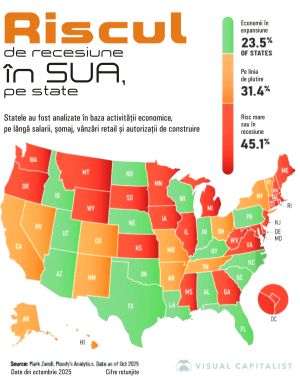The global cryptocurrency market cap is currently worth nearly $3 trillion, according to visualcapitalist.com, which ranks the world's largest cryptocurrencies in 2025, showing how value is distributed across major networks, stablecoins, and emerging digital assets, based on CoinMarketCap data. The market cap figures for the largest cryptocurrencies are as of November 11, 2025. Market cap is calculated by multiplying the price of a token by its circulating supply
• Bitcoin and Ethereum - the core of the crypto landscape
Bitcoin remains the clear market leader with nearly $2 trillion, reflecting its status as the most widely held and institutionally recognized crypto asset. Ethereum follows with $391 billion, supported by its role as a leading smart contract platform. Together, the two represent the core of the crypto landscape. Next comes Tether, with around $184 billion, XRP - $140 billion, BNB - $127 billion, Solana - $80 billion, USDC - $76 billion, TRON - around $28 billion, Dogecoin - almost $25 billion, Cardano - $19 billion.
• Stablecoins and Alternative Layer-1 Networks on the Rise
Stablecoins are cryptocurrencies designed to maintain a constant value, typically by being pegged to fiat currencies, commodities, or other financial instruments. They serve as a bridge between traditional finance and digital markets, providing price stability that makes them useful for trading, payments, and storing value on-chain.
Stablecoins like Tether and USDC now hold significant market positions, with a market cap of $184 billion and $76 billion, respectively. Their rapid growth reflects the growing demand for reliable, dollar-pegged assets across exchanges, payment networks, and decentralized finance applications.
• Emerging Assets and New Market Names
Beyond the major players, a range of mid-sized tokens have gained traction, the source notes. Projects like Hyperliquid, Chainlink, and Hedera highlight strong demand for specialized tools, such as oracle data, liquidity infrastructure, and enterprise-grade networks. Meme and community-based tokens, including Dogecoin, Shiba Inu, and Pepe, remain notable for their cultural influence despite more volatile fundamentals.
• Bitget: Bitcoin correction wiped hundreds of billions from the crypto market. What could the next moves look like?
After peaking at nearly $126,000 in early October, Bitcoin has fallen more than 20% in the past month, briefly falling below $84,000. The sharp correction wiped hundreds of billions of dollars off the total value of the crypto market and caught investors by surprise, triggering a sharp change in sentiment among market participants, according to Bitget, the world's largest universal exchange.
The drop is all the more significant as it interrupts Bitcoin's consolidation trend in traditional finance, which has been supported in recent months by record inflows into spot ETFs and an accelerated increase in institutional adoption. Now, with the sharp change in market sentiment, investors are bracing for a period of high volatility, with the Crypto Fear & Greed Index at just 19 points, a level considered "extreme fear.”
While the current sharp decline is significant, it cannot be compared to a genuine bear market, which typically involves systemic crashes and much more severe losses, the source notes. A relevant example is the "crypto winter” of 2022, when Bitcoin plummeted 77% from $69,000 to $15,768, following a series of major events that included the Luna collapse, the FTX fraud, and the Celsius bankruptcy. It was a moment with existential implications for the entire sector.
The current correction is a classic example of bull market behavior. Its magnitude aligns with past pullbacks, comparable to the 40% drop in September 2017 and the 53% drop in May 2021, both of which were followed by explosive rallies to new all-time highs, Bitget explains.
Unlike 2022, Bitcoin's fundamental infrastructure remains solid and continues to strengthen. Bitcoin ETFs now hold $128 billion in assets, or 1.33 million BTC, and listed companies control over 800,000 BTC. The hash rate, which reflects the computing power that ensures the security of the network, remains at record levels, although miners' margins continue to shrink. In addition, a crypto-friendly US administration has reversed some of the restrictive regulations of the past. When fear reaches extreme levels and infrastructure continues to consolidate, history shows that this is exactly where significant opportunities arise.
• Bitget: On-chain signals point to aggressive accumulation
While retail investors are showing signs of capitulation, on-chain data shows that sophisticated players are using the decline to accumulate massively. According to CryptoQuant, large investors ("whales”) have bought over 375,000 BTC in the last 30 days, and the week of November 13th became the second most intense week of accumulation in 2025, with over 45,000 BTC added. The same dynamic was observed in March 2025, before the rally that took Bitcoin to new all-time highs.
Miner behavior sends the same message, according to Bitget. Although the hashprice (i.e. the income that miners get for each unit of computing power) has fallen to its lowest level in five years, and operating margins have fallen to 48%, miners continue to hold Bitcoin, not sell it. Their daily output has collapsed from 23,000 BTC in February 2025 to just 3,672 BTC in November. In addition, miners from the "Satoshi era” remain confident and have sold only 150 BTC in all of 2025, compared to 10,000 BTC in 2024 - a decrease of 98.5%, Bitget points out.
Another strong signal is the massive capital "on the sidelines”. The total supply of stablecoins has increased between $252 billion and $303 billion, with $48 billion entering circulation in the first half of 2025 alone. USDC rose by $25 billion after the US election, while Bitcoin was in a correction. This development shows that investors are accumulating liquid capital, preparing to re-enter the market. Stablecoins now process over $27 trillion annually, exceeding the combined volumes of Visa and Mastercard.
• Bitget: Extreme fear usually anticipates major rallies
The Crypto Fear & Greed Index fell to 11 on November 18. Such levels have only been seen during the FTX collapse of 2022 and the sharp decline in March 2020. However, the current situation is fundamentally different. In March 2020, Bitcoin was trading at around $4,000 and later rose to over $60,000. In September 2024, when the index reached a similar level, Bitcoin rose from $53,000 to $106,000 in three months. In February 2025, a 10-point index value at $75,000 was followed by a 25% increase in four weeks and, ultimately, new all-time highs, according to Bitget, which notes: "Historically speaking, when the index drops below 20, the average increase in the next 15 days exceeds 22%, and returns over 3-12 months range from 200% to 300%.”
The $20 billion in liquidations since October 10th, while painful, have served a necessary purpose: to eliminate over-leveraged positions and excessive speculation. This "cleaning” of the market structure is a typical process in bull phases.
This market reset should not be interpreted as a warning signal, but as a necessary step before the macro growth cycle continues, Bitget adds.























































